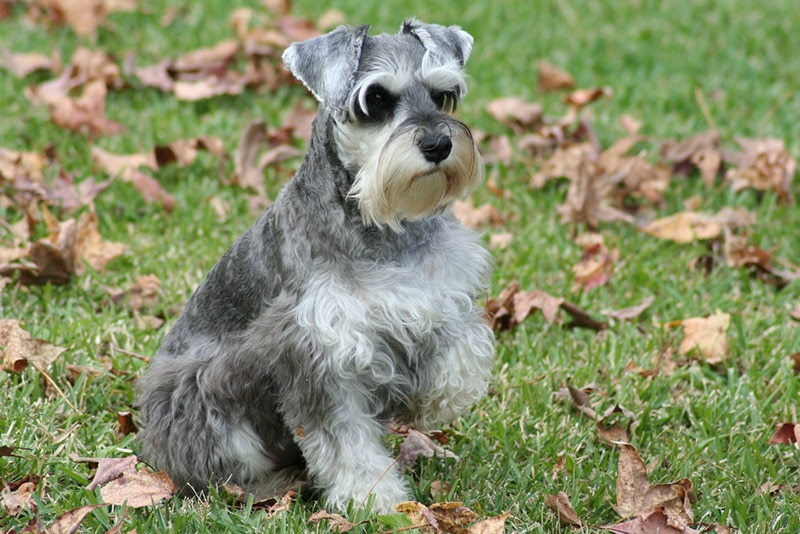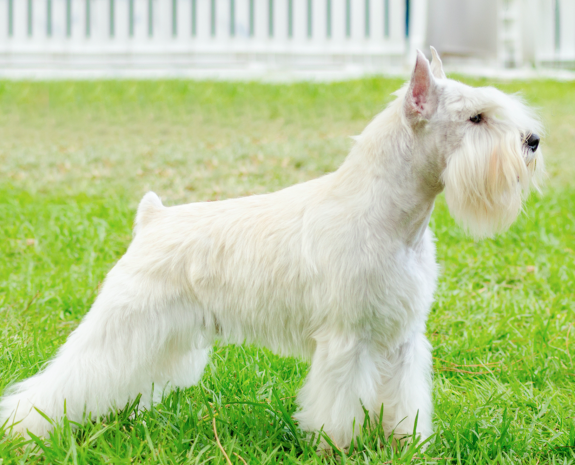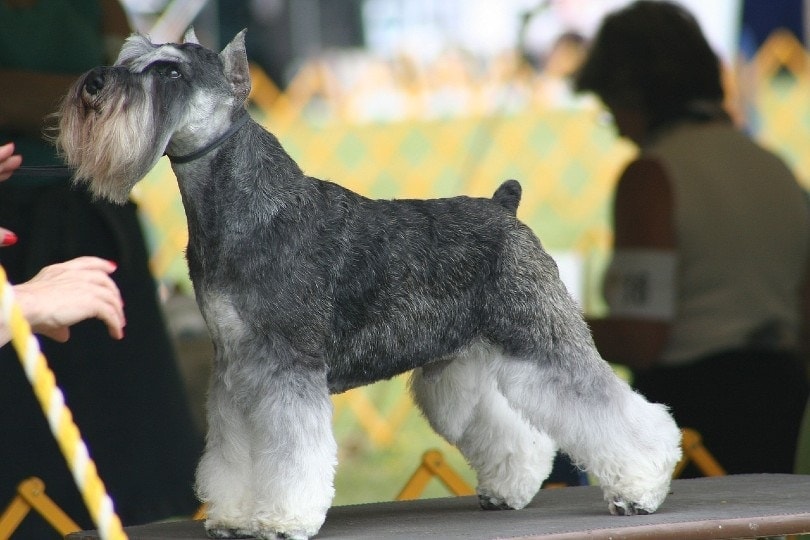The Miniature schnauzer, with its charming personality and sturdy build, has captivated hearts worldwide. While the classic black and salt and pepper coats are well-known, a fascinating world of rare and unique colors lies beneath the surface. These unusual hues, often a result of genetic variations, add an extra layer of charm and exclusivity to this already beloved breed. In this article, we will delve into the genetics behind these rare colors, showcase some of the most sought-after shades, and discuss important factors to consider when choosing a rare Miniature Schnauzer.
Beyond Black and Salt Pepper: Unveiling the Spectrum of Rare Miniature Schnauzer Colors

Delving into the Genetics:
The Miniature Schnauzer’s coat color is determined by a complex interplay of several genes. The primary genes involved are responsible for black (B), brown (b), and a dominant black gene (A) which affects the expression of other color genes. The A gene can mask the expression of both brown and black, resulting in solid black coats. However, when certain variations occur in these genes, it can lead to rare and unique coat colors that are highly sought after by breeders and dog lovers alike.
The Spectrum of Rare Colors:
While black and salt and pepper dominate the Miniature Schnauzer scene, the following rare colors offer a glimpse into the breed’s genetic diversity:
1. White:
A true white Miniature Schnauzer is a rare sight. This color is caused by a recessive gene that prevents the production of melanin, the pigment responsible for coat color. White Schnauzers often have light-colored eyes and noses. While these dogs are usually healthy, they can be prone to certain health concerns, such as deafness, so it’s crucial to ensure they come from reputable breeders.
In addition to the recessive gene that causes their white coat, white Miniature Schnauzers can also have a “parti” or piebald gene. This gene can result in a white coat with patches of black, brown, or salt and pepper. Parti-colored Schnauzers are even rarer than solid white ones, and they often have striking and unique patterns on their coats.
Unordered List:
- White Miniature Schnauzers are often mistaken for albino dogs, but this is not the case. Albinism is a genetic condition where there is a complete lack of melanin production, resulting in a white coat, pink skin, and red eyes.
- Some breeders intentionally breed for white Miniature Schnauzers, while others may occur randomly in a litter.
- The American Kennel Club (AKC) recognizes white as a rare color for Miniature Schnauzers, but it is not accepted in the show ring.
2. Liver:
Liver-colored Miniature Schnauzers boast a rich, warm brown coat that can range from a deep chocolate to a lighter cinnamon shade. This color is caused by a variation in the B gene, which allows the production of eumelanin, the pigment responsible for black and brown coats. Liver Miniature Schnauzers often have hazel or amber colored eyes, adding to their unique appearance.
Similar to white Miniature Schnauzers, liver-colored ones can also have parti genes, resulting in a white and brown coat. These dogs are known as “liver and white” or “chocolate and white” Schnauzers and are highly sought after for their striking and rare coloring.
Table:
| Littermate Colors | Possible Offspring Colors |
|---|---|
| Black x Black | Black, Salt Pepper |
| Black x Salt Pepper | Black, Salt Pepper, Liver, White |
| Salt Pepper x Salt Pepper | Black, Salt Pepper, White |
| Liver x Liver | Liver, White |
| White x White | White, Parti-colored |
| Liver x White | Liver, White, Parti-colored |
3. Red:
Red Miniature Schnauzers are another rare and unique color that results from a variation in the B gene. This color can range from a deep mahogany to a light apricot shade and often has darker points on the ears, muzzle, and tail. While typically seen in other breeds such as Poodles or Dachshunds, red Miniature Schnauzers are rarely seen and highly sought after by dog enthusiasts.
In some cases, red Miniature Schnauzers may have a parti gene, resulting in white patches on their coats. These dogs are known as “red and white” Schnauzers and are often considered even more rare and desirable.
Unordered List:
- Some breeders intentionally breed for red Miniature Schnauzers, while others may occur randomly in a litter.
- The AKC does not recognize red as an accepted color for Miniature Schnauzers in the show ring.
- Like liver-colored Schnauzers, red ones can also have hazel or amber colored eyes.
From White to Liver: A Guide to Rare Miniature Schnauzer Coat Colors and Patterns

While the rare colors mentioned above are among the most sought after, there are several other variations and patterns that can appear in Miniature Schnauzers. Here is a guide to some of these unique colors and patterns:
1. Merle:
Merle is a pattern that appears in many different breeds, including the Miniature Schnauzer. It is caused by a dominant gene that creates a marbled effect on the coat, often with patches of lighter or darker shades. Merle Miniature Schnauzers can come in a variety of colors, such as blue merle, red merle, and even chocolate merle.
Unordered List:
- Merle Miniature Schnauzers have a higher risk of health concerns such as deafness, blindness, and skin issues due to the gene’s effects on pigment production.
- While striking, merle is not an accepted color for Miniature Schnauzers in the show ring.
- Some breeders intentionally breed for merle Miniature Schnauzers, while others may occur randomly in a litter.
2. Black and Silver:
Black and silver Miniature Schnauzers are often mistaken for salt and pepper ones due to their similar coloring. However, there are some key differences between the two. A black and silver Schnauzer has a solid black coat with silver markings on the eyebrows, whiskers, and chest. In contrast, a salt and pepper Schnauzer has a dark grey coat with a mixture of lighter hairs throughout the body.
Unordered List:
- Black and silver Miniature Schnauzers were once considered the same color as salt and pepper but were recognized as a separate color by the AKC in 1929.
- Some breeders intentionally breed for black and silver Miniature Schnauzers, while others may occur randomly in a litter.
- This color is accepted in the show ring and can compete in the same classes as black and salt and pepper Miniature Schnauzers.
3. Phantom:
A phantom Miniature Schnauzer is another unique variation that results from a combination of the A and B genes. This pattern creates a bi-colored coat, with one color appearing on the body and the other on the legs, tail, and face. Phantoms can come in a variety of colors, such as black and tan, liver and tan, or even red and white.
Unordered List:
- Phantom Miniature Schnauzers are often confused with parti-colored ones, but the difference lies in the distribution of color. Phantoms have a clear division between the two colors, whereas parti-colored Schnauzers have random markings.
- This pattern is not accepted in the show ring and is considered a fault in breeding standards.
- Some breeders intentionally breed for phantom Miniature Schnauzers, while others may occur randomly in a litter.
The Allure of the Unusual: Why Rare Miniature Schnauzer Colors are Highly Sought After

The popularity of rare Miniature Schnauzer colors has increased over the years, with breeders and dog lovers alike drawn to their uniqueness and exclusivity. These colors often come at a premium price, making them even more desirable to some. But what exactly is it about these rare shades that make them so highly sought after?
Firstly, these colors add an extra level of charm and individuality to the already beloved Miniature Schnauzer breed. They make each dog stand out and become a conversation starter wherever they go. Additionally, many dog owners enjoy the challenge of finding a reputable breeder that can produce a specific rare color or pattern, adding to the excitement and adventure of owning a Miniature Schnauzer.
Moreover, these rare colors also hold sentimental value for some owners. Many have a personal attachment to a specific color or pattern, whether it reminds them of a childhood pet or holds a special meaning to them. In these cases, owning a rare Miniature Schnauzer with that particular color or pattern can be a dream come true.
Breeding for Color: Understanding the Genetics Behind Rare Miniature Schnauzer Coats

With the increasing demand for rare Miniature Schnauzer colors, it’s essential to understand the genetics behind these colors and patterns. As mentioned earlier, coat color in this breed is influenced by several genes, and it’s crucial to have a basic understanding of these to produce specific colors or patterns.
Breeding for rare colors can be a complex process, and it’s essential to seek guidance from reputable breeders who have experience in producing these shades. They will be able to provide information on the different genes involved, the likelihood of producing certain colors or patterns, and any potential health concerns that may arise.
Additionally, reputable breeders will also ensure that their dogs are properly health tested and cared for, reducing the risk of any health issues being passed on to their offspring. It is crucial to avoid supporting unethical breeders who prioritize profit over the well-being of their dogs and only breed for rare colors without proper knowledge or consideration for genetics.
Beyond Aesthetics: Factors to Consider When Choosing a Rare Miniature Schnauzer

While owning a rare Miniature Schnauzer color can be exciting, there are several essential factors to consider before bringing home one of these unique dogs.
Firstly, it’s crucial to ensure that the breeder you choose is reputable and has a good track record of breeding healthy and genetically sound dogs. This is especially important when it comes to rare colors, as some genetic variations can result in health concerns, as discussed earlier.
Moreover, it’s crucial to remember that coat color should not be the only factor in choosing a Miniature Schnauzer. Temperament, health, and overall conformation should be the main considerations, with color being an added bonus. A dog’s personality and your compatibility with them should always take precedence over aesthetics.
Lastly, it’s important to keep in mind that rare colors can come at a premium price. While this may not be an issue for some, it’s essential to ensure that you are financially prepared to provide for your dog’s needs, including proper healthcare and nutrition.
Conclusion
In conclusion, the Miniature Schnauzer’s classic black and salt and pepper coats may be well-known, but beneath the surface lies a world of rare and unique colors. From white to liver, red to phantom, these rare hues add an extra layer of charm and exclusivity to this beloved breed. Understanding the genetics behind these colors and patterns is crucial for those looking to breed or own a rare Miniature Schnauzer. However, it’s important to remember that coat color should not be the only factor in choosing a dog, and health and temperament should always remain top priorities. With proper care and consideration, rare Miniature Schnauzers can continue to captivate hearts worldwide with their beauty and individuality.
